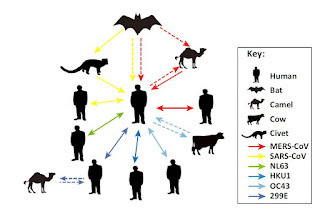CORONAVIRUS
Coronaviruses
They are infectious disease and have a large family of viruses which are generally known to affect birds and mammals, including humans. It cause illness like common cold, Middle East Respiratory Syndrome(MERS), Severe Acute Respiratory Syndrome(SARS) and many acute disease. They are named from the crown-like spikes on their surface.
The structure of coronavirus consist of several parts
- internal part is RNA and N protein
- part which cover protein is Envelope(85nm)
- cover contain membrane protein(125nm)
- outer part is Spike protein(20nm)
Origin
Coronavirus were discovered in year 1930 which was an acute respiretory infection
found in chickens and the virus was Infectious Bronchities Virus (IBV) . In year 1940 the virus was found in mouse which was Mouse Hepatitis Virus (MHV) and Transmissible Gastroenteritis Virus(TGEV), the human coronavirus was discovered in year 1960 which was Human Coronavirus 229E (HCOV-229E)
Coronavirus were discovered in year 1930 which was an acute respiretory infection
found in chickens and the virus was Infectious Bronchities Virus (IBV) . In year 1940 the virus was found in mouse which was Mouse Hepatitis Virus (MHV) and Transmissible Gastroenteritis Virus(TGEV), the human coronavirus was discovered in year 1960 which was Human Coronavirus 229E (HCOV-229E)
Classification
They are generally classified as Alpha(TGEV), Beta(MHV), Gama(IBV) and Delta out of these alphacoronavirus and betacoronavirus infect mammals and gamacoronavirus and deltacoronavirus which infect birds.
Species Genus
Alphacoronavirus
Bat coronavirus CDPHE15
Bat coronavirus HKU10
Human coronavirus 229E
Human coronavirus NL63
Miniopterus bat coronavirus 1
Miniopterus bat coronavirus HKU8
Mink coronavirus 1
Porcine epidemic diarrhoea virus
Rhinolophus bat coronavirus HKU2
Scotophilus bat coronavirus 512
Betacoronavirus
Betacoronavirus 1
Hedgehog coronavirus 1
Human coronavirus HKU1
Middle East respiratory
syndrome-related coronavirus
syndrome-related coronavirus
Murine coronavirus
Pipistrellus bat coronavirus HKU5
Rousettus bat coronavirus HKU9
Severe acute respiratory syndrome-
related coronavirus
related coronavirus
Tylonycteris bat coronavirus HKU4
Deltacoronavirus
Bulbul coronavirus HKU11
Bulbul coronavirus HKU11
Common moorhen coronavirus HKU21
Coronavirus HKU15
Munia coronavirus HKU13
Night heron coronavirus HKU19
Thrush coronavirus HKU12
White-eye coronavirus HKU16
Wigeon coronavirus HKU20
Gammacoronavirus
Avian coronavirus
Avian coronavirus
Beluga whale coronav
Spread
Infection occurs when viruses , bacteria or other microbes enter your body and begin to multiply. They damage your body cells which result in infection an cause illness.
- they are spread through one host to another
- it spread through solid waste or bio waste which are generated by human
- it can also spread through Formites .
-
it can spread through fly , shaking hands, kissing, while sneezingand etc
- infected person are the best environment for replication of the virus/
- in human it generally infect the epithelial cells of the respiratory.
- in animals it infect the epithelial cells of digestive tract.
Symptoms
To show these symptoms if person get infected with these virus it take 5 to 6 days or it may take 14 days from the day if infected.
Precaution
1.Avoid close contact with people who are sick.
2. Maintain at least three feet distance between
yourself and anyone who is coughing
or sneezing.
or sneezing.
3.Avoid touching your eyes, nose, and mouth.
4.Cover your cough or sneeze with a tissue,
then dispose of the tissue safely.
5.Clean and disinfect frequently-touched
objects and surfaces using a regular
household cleaning spray or wipe.
6.Wearing a mask is not necessary unless
you are taking care of an infected person.
7.Always wash hands with soap and water
when hands are visibly dirty.
8.If you have a fever, cough and difficulty
breathing, seek medical attention
immediately.
immediately.
https://wildlifeacts123.blogspot.com/?m



![Professional Networking For Jobs [DIY] : Raúl Velázquez](https://www.raulvelazquezphd.com/wp-content/uploads/2017/10/Networking-1.jpg)


